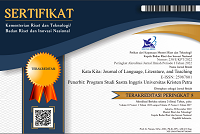Liking What You See: A Study on the Motives Behind Instagram Likes
DOI:
https://doi.org/10.9744/katakita.10.1.160-166Keywords:
Buku, Fotografi Cerita, Kain Tenun Pagatan, FashionAbstract
The world has never been more connected than it is today and one key contributor to that fact is the growth of social networking sites. With the sum of about 4.2 billion active users, more than half of the human population, social networking sites have become a highway for information. From holding private conversations to appreciating others’ posts, social media users leave crumbs of information – one of which is a “Like”. ‘Like’ carries a plethora of information, and decoding it offers invaluable insight. This research aims to study the motives behind the act of ‘Liking’ an Instagram post. Following the data collection, an analysis using Albert Bandura’s Social Cognitive Theory will be carried out. With it, the researcher concluded that the motives behind ‘Liking’ an Instagram posts are to manage relationship, form an identity, state affinity, provide support, and prompt similar behavior.
Keywords: Social media, Instagram, Instagram Like, Social Cognitive Theory (SCT), Motives
References
Bandura, A. (1977). Social learning theory. Prentice-Hall.
Belk, R. W. (1988). Possessions and the Extended Self. Journal of Consumer Research, 15(2),
139. https://doi.org/10.1086/209154
Blease, C. R. (2015). Too Many ‘Friends,’ Too Few ‘Likes’? Evolutionary Psychology and
‘Facebook Depression.’ Review of General Psychology, 19(1), 1–13.
https://doi.org/10.1037/gpr0000030
Burrow, A. L., & Rainone, N. (2017). How many likes did i get?: Purpose moderates links
between positive social media feedback and self-esteem. Journal of Experimental
Social Psychology, 69, 232–236. https://doi.org/10.1016/j.jesp.2016.09.005
Butler, J. (2002). Judith Butler: Bodies and power, revisited / Radical Philosophy. Radical
Philosophy. https://www.radicalphilosophy.com/article/bodies-and-power-revisited.
Cassell, C., Symon, G., & Brewer, J. D. (2014). Ethnography. In Essential guide to qualitative
methods in organizational research (p. 312). essay, Sage.
Coulthard, N., & Ogden, J. (2018). The impact of posting selfies and gaining feedback (‘likes’)
on the psychological wellbeing of 16-25 year olds: An experimental study.
Cyberpsychology: Journal of Psychosocial Research on Cyberspace, 12(2).
https://doi.org/10.5817/cp2018-2-4
Dharamsi, S., & Charles, G. (2011). Ethnography: traditional and criticalist conceptions of a
qualitative research method. Canadian Family Physician, 57.
https://www.ncbi.nlm.nih.gov/pmc/articles/PMC3056692/.
Foucault, M. (1978). The History of Sexuality. Pantheon Books.
Garson, G. D. (2015). Ethnographic Research. Asheboro, NC: Statistical Associates Publishers
Kemp, S. (2021, March 8). Digital 2021: Global OVERVIEW report - DATAREPORTAL
global Digital insights. https://datareportal.com/reports/digital-2021-global-overview
report.
Landry, C. C. (2003). Self-efficacy, motivation, and outcome expectation correlates of college
students' intention certainty (Doctoral dissertation, Louisiana State University, 2003).
Baton Rouge, LA, Louisiana: Louisiana State University.
Leppänen, S., Kytölä, S., Jousmäki, H., Peuronen, S., & Westinen, E. (2014). Entextualization
and resemiotization as resources for identification in social media. The Language of
Social Media, 112–136. https://doi.org/10.1057/9781137029317_6
Ozanne, M., Cueva Navas, A., Mattila, A. S., & Van Hoof, H. B. (2017). An Investigation Into
Facebook “Liking” Behavior An Exploratory Study. Social Media + Society, 3(2),
205630511770678. https://doi.org/10.1177/2056305117706785
Rosenthal-von der Pütten, A. M., Hastall, M. R., Köcher, S., Meske, C., Heinrich, T., Labrenz,
F., & Ocklenburg, S. (2019). “Likes” as social rewards: Their role in online social
comparison and decisions to like other people's selfies. Computers in Human Behavior,
92, 76-86. doi:10.1016/j.chb.2018.10.017
Tankovska, H. (2021, February 10). Instagram: age distribution of global audiences 2021.
Statista. https://www.statista.com/statistics/325587/instagram-global-age-group/.
Downloads
Published
Issue
Section
License
Authors who publish with this journal agree to the following terms:- Authors retain copyright and grant the journal right of first publication with the work simultaneously licensed under a Creative Commons Attribution License that allows others to share the work with an acknowledgement of the work's authorship and initial publication in this journal.
- Authors are able to enter into separate, additional contractual arrangements for the non-exclusive distribution of the journal's published version of the work (e.g., post it to an institutional repository or publish it in a book), with an acknowledgement of its initial publication in this journal.
- Authors are permitted and encouraged to post their work online (e.g., in institutional repositories or on their website) prior to and during the submission process, as it can lead to productive exchanges, as well as earlier and greater citation of published work (See The Effect of Open Access).














